2007 CHEVROLET SILVERADO wheel
[x] Cancel search: wheelPage 109 of 684

Keys............................................................ 111
Remote Keyless Entry (RKE) System........ 112
Remote Keyless Entry (RKE) System
Operation............................................... 113
Doors and Locks........................................ 120
Door Locks................................................ 120
Power Door Locks..................................... 121
Delayed Locking........................................ 121
Programmable Automatic Door Locks........ 121
Rear Door Security Locks......................... 122
Lockout Protection..................................... 122
Rear Doors............................................... 123
Tailgate..................................................... 124
Windows...................................................... 126
Manual Windows....................................... 126
Power Windows........................................ 127
Power Sliding Rear Window...................... 128
Sun Visors................................................ 129
Theft-Deterrent Systems............................. 129
Content Theft-Deterrent............................. 130
PASS-Key
®III+......................................... 131
PASS-Key®III+ Operation......................... 132Starting and Operating Your Vehicle......... 134
New Vehicle Break-In................................ 134
Ignition Positions....................................... 135
Retained Accessory Power (RAP)............. 136
Starting the Engine.................................... 136
Adjustable Throttle and Brake Pedal.......... 138
Engine Coolant Heater.............................. 138
Active Fuel Management™........................ 140
Automatic Transmission Operation............. 140
Tow/Haul Mode......................................... 146
Four-Wheel Drive...................................... 149
Parking Brake........................................... 164
Shifting Into Park (P)................................. 165
Shifting Out of Park (P)............................. 167
Parking Over Things That Burn................. 168
Engine Exhaust......................................... 169
Running the Engine While Parked............. 170
Mirrors......................................................... 171
Manual Rearview Mirror............................. 171
Automatic Dimming Rearview Mirror with
OnStar
®, Compass and Temperature
Display................................................... 171
Section 2 Features and Controls
109
Page 135 of 684
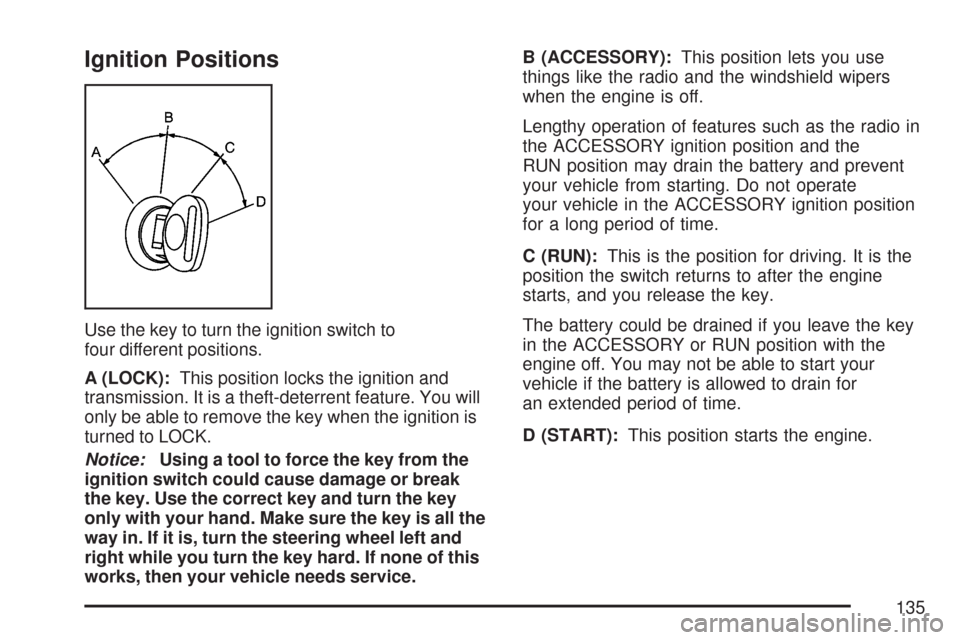
Ignition Positions
Use the key to turn the ignition switch to
four different positions.
A (LOCK):This position locks the ignition and
transmission. It is a theft-deterrent feature. You will
only be able to remove the key when the ignition is
turned to LOCK.
Notice:Using a tool to force the key from the
ignition switch could cause damage or break
the key. Use the correct key and turn the key
only with your hand. Make sure the key is all the
way in. If it is, turn the steering wheel left and
right while you turn the key hard. If none of this
works, then your vehicle needs service.B (ACCESSORY):This position lets you use
things like the radio and the windshield wipers
when the engine is off.
Lengthy operation of features such as the radio in
the ACCESSORY ignition position and the
RUN position may drain the battery and prevent
your vehicle from starting. Do not operate
your vehicle in the ACCESSORY ignition position
for a long period of time.
C (RUN):This is the position for driving. It is the
position the switch returns to after the engine
starts, and you release the key.
The battery could be drained if you leave the key
in the ACCESSORY or RUN position with the
engine off. You may not be able to start your
vehicle if the battery is allowed to drain for
an extended period of time.
D (START):This position starts the engine.
135
Page 140 of 684
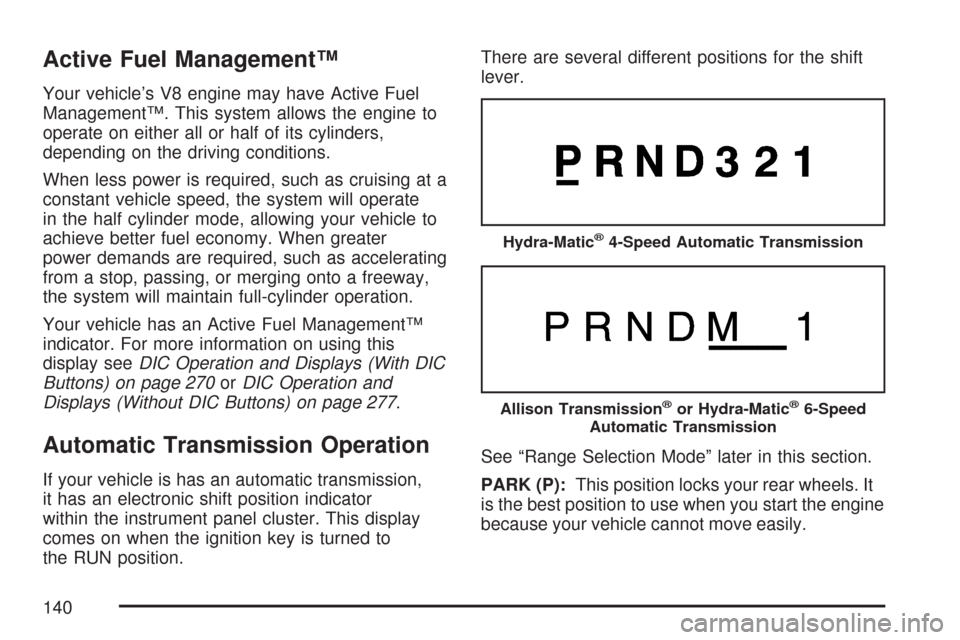
Active Fuel Management™
Your vehicle’s V8 engine may have Active Fuel
Management™. This system allows the engine to
operate on either all or half of its cylinders,
depending on the driving conditions.
When less power is required, such as cruising at a
constant vehicle speed, the system will operate
in the half cylinder mode, allowing your vehicle to
achieve better fuel economy. When greater
power demands are required, such as accelerating
from a stop, passing, or merging onto a freeway,
the system will maintain full-cylinder operation.
Your vehicle has an Active Fuel Management™
indicator. For more information on using this
display seeDIC Operation and Displays (With DIC
Buttons) on page 270orDIC Operation and
Displays (Without DIC Buttons) on page 277.
Automatic Transmission Operation
If your vehicle is has an automatic transmission,
it has an electronic shift position indicator
within the instrument panel cluster. This display
comes on when the ignition key is turned to
the RUN position.There are several different positions for the shift
lever.
See “Range Selection Mode” later in this section.
PARK (P):This position locks your rear wheels. It
is the best position to use when you start the engine
because your vehicle cannot move easily.
Hydra-Matic®4-Speed Automatic Transmission
Allison Transmission®or Hydra-Matic®6-Speed
Automatic Transmission
140
Page 141 of 684
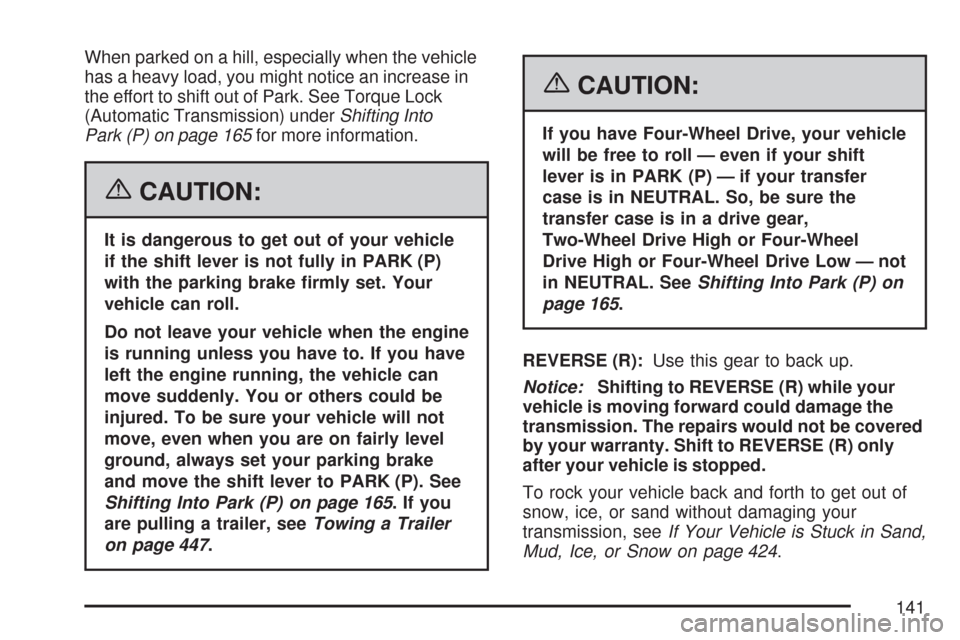
When parked on a hill, especially when the vehicle
has a heavy load, you might notice an increase in
the effort to shift out of Park. See Torque Lock
(Automatic Transmission) underShifting Into
Park (P) on page 165for more information.
{CAUTION:
It is dangerous to get out of your vehicle
if the shift lever is not fully in PARK (P)
with the parking brake �rmly set. Your
vehicle can roll.
Do not leave your vehicle when the engine
is running unless you have to. If you have
left the engine running, the vehicle can
move suddenly. You or others could be
injured. To be sure your vehicle will not
move, even when you are on fairly level
ground, always set your parking brake
and move the shift lever to PARK (P). See
Shifting Into Park (P) on page 165.Ifyou
are pulling a trailer, seeTowing a Trailer
on page 447.
{CAUTION:
If you have Four-Wheel Drive, your vehicle
will be free to roll — even if your shift
lever is in PARK (P) — if your transfer
case is in NEUTRAL. So, be sure the
transfer case is in a drive gear,
Two-Wheel Drive High or Four-Wheel
Drive High or Four-Wheel Drive Low — not
in NEUTRAL. SeeShifting Into Park (P) on
page 165.
REVERSE (R):Use this gear to back up.
Notice:Shifting to REVERSE (R) while your
vehicle is moving forward could damage the
transmission. The repairs would not be covered
by your warranty. Shift to REVERSE (R) only
after your vehicle is stopped.
To rock your vehicle back and forth to get out of
snow, ice, or sand without damaging your
transmission, seeIf Your Vehicle is Stuck in Sand,
Mud, Ice, or Snow on page 424.
141
Page 142 of 684
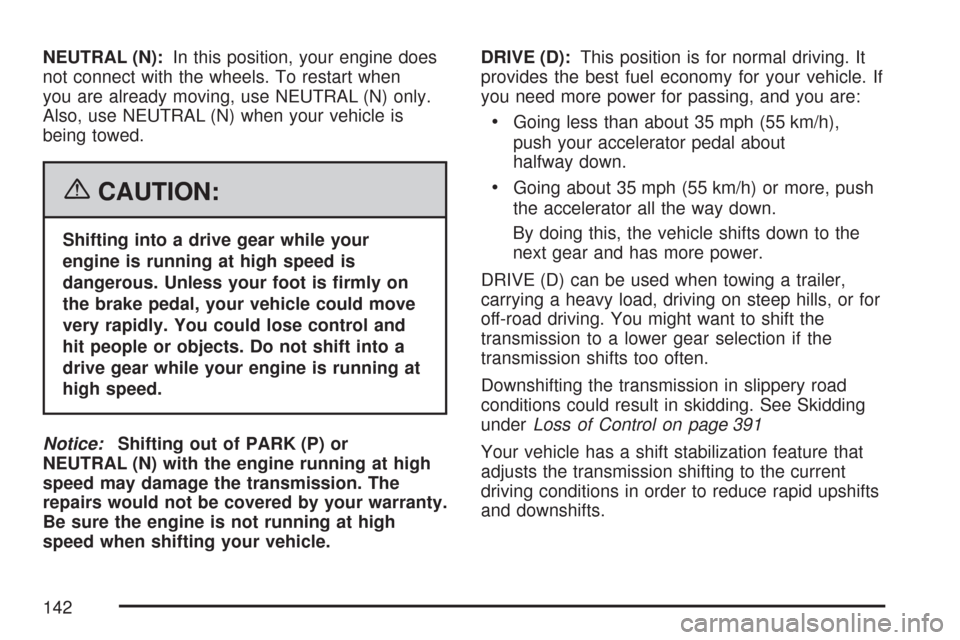
NEUTRAL (N):In this position, your engine does
not connect with the wheels. To restart when
you are already moving, use NEUTRAL (N) only.
Also, use NEUTRAL (N) when your vehicle is
being towed.
{CAUTION:
Shifting into a drive gear while your
engine is running at high speed is
dangerous. Unless your foot is �rmly on
the brake pedal, your vehicle could move
very rapidly. You could lose control and
hit people or objects. Do not shift into a
drive gear while your engine is running at
high speed.
Notice:Shifting out of PARK (P) or
NEUTRAL (N) with the engine running at high
speed may damage the transmission. The
repairs would not be covered by your warranty.
Be sure the engine is not running at high
speed when shifting your vehicle.DRIVE (D):This position is for normal driving. It
provides the best fuel economy for your vehicle. If
you need more power for passing, and you are:
Going less than about 35 mph (55 km/h),
push your accelerator pedal about
halfway down.
Going about 35 mph (55 km/h) or more, push
the accelerator all the way down.
By doing this, the vehicle shifts down to the
next gear and has more power.
DRIVE (D) can be used when towing a trailer,
carrying a heavy load, driving on steep hills, or for
off-road driving. You might want to shift the
transmission to a lower gear selection if the
transmission shifts too often.
Downshifting the transmission in slippery road
conditions could result in skidding. See Skidding
underLoss of Control on page 391
Your vehicle has a shift stabilization feature that
adjusts the transmission shifting to the current
driving conditions in order to reduce rapid upshifts
and downshifts.
142
Page 144 of 684
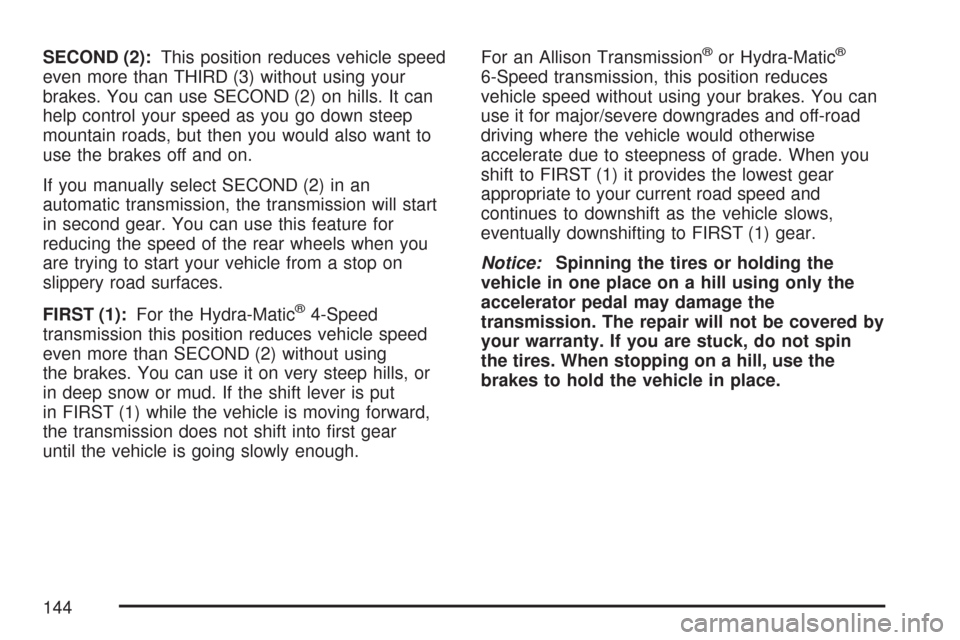
SECOND (2):This position reduces vehicle speed
even more than THIRD (3) without using your
brakes. You can use SECOND (2) on hills. It can
help control your speed as you go down steep
mountain roads, but then you would also want to
use the brakes off and on.
If you manually select SECOND (2) in an
automatic transmission, the transmission will start
in second gear. You can use this feature for
reducing the speed of the rear wheels when you
are trying to start your vehicle from a stop on
slippery road surfaces.
FIRST (1):For the Hydra-Matic
®4-Speed
transmission this position reduces vehicle speed
even more than SECOND (2) without using
the brakes. You can use it on very steep hills, or
in deep snow or mud. If the shift lever is put
in FIRST (1) while the vehicle is moving forward,
the transmission does not shift into �rst gear
until the vehicle is going slowly enough.For an Allison Transmission
®or Hydra-Matic®
6-Speed transmission, this position reduces
vehicle speed without using your brakes. You can
use it for major/severe downgrades and off-road
driving where the vehicle would otherwise
accelerate due to steepness of grade. When you
shift to FIRST (1) it provides the lowest gear
appropriate to your current road speed and
continues to downshift as the vehicle slows,
eventually downshifting to FIRST (1) gear.
Notice:Spinning the tires or holding the
vehicle in one place on a hill using only the
accelerator pedal may damage the
transmission. The repair will not be covered by
your warranty. If you are stuck, do not spin
the tires. When stopping on a hill, use the
brakes to hold the vehicle in place.
144
Page 146 of 684
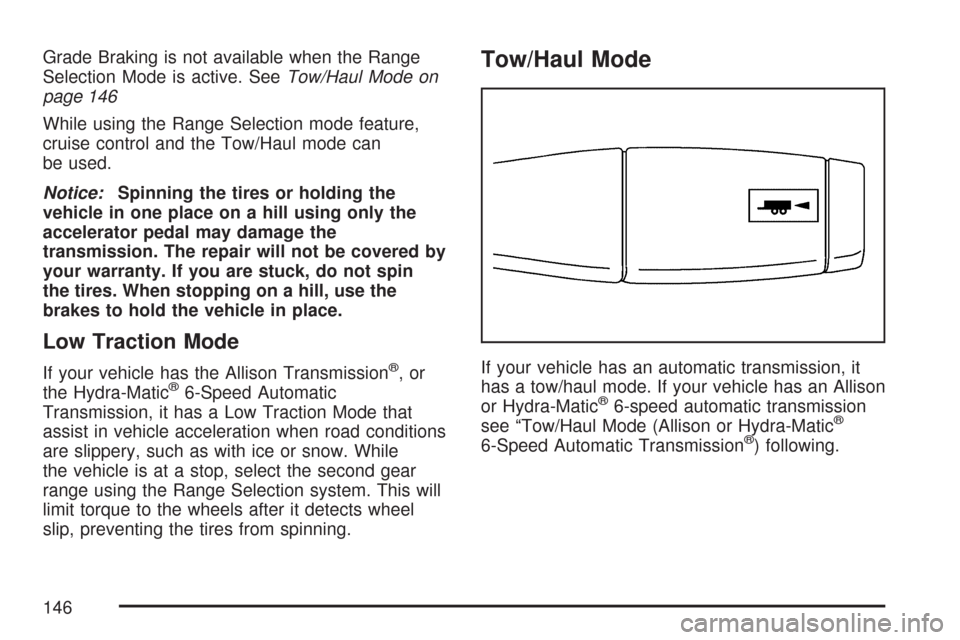
Grade Braking is not available when the Range
Selection Mode is active. SeeTow/Haul Mode on
page 146
While using the Range Selection mode feature,
cruise control and the Tow/Haul mode can
be used.
Notice:Spinning the tires or holding the
vehicle in one place on a hill using only the
accelerator pedal may damage the
transmission. The repair will not be covered by
your warranty. If you are stuck, do not spin
the tires. When stopping on a hill, use the
brakes to hold the vehicle in place.
Low Traction Mode
If your vehicle has the Allison Transmission®,or
the Hydra-Matic®6-Speed Automatic
Transmission, it has a Low Traction Mode that
assist in vehicle acceleration when road conditions
are slippery, such as with ice or snow. While
the vehicle is at a stop, select the second gear
range using the Range Selection system. This will
limit torque to the wheels after it detects wheel
slip, preventing the tires from spinning.
Tow/Haul Mode
If your vehicle has an automatic transmission, it
has a tow/haul mode. If your vehicle has an Allison
or Hydra-Matic
®6-speed automatic transmission
see “Tow/Haul Mode (Allison or Hydra-Matic®
6-Speed Automatic Transmission®) following.
146
Page 149 of 684
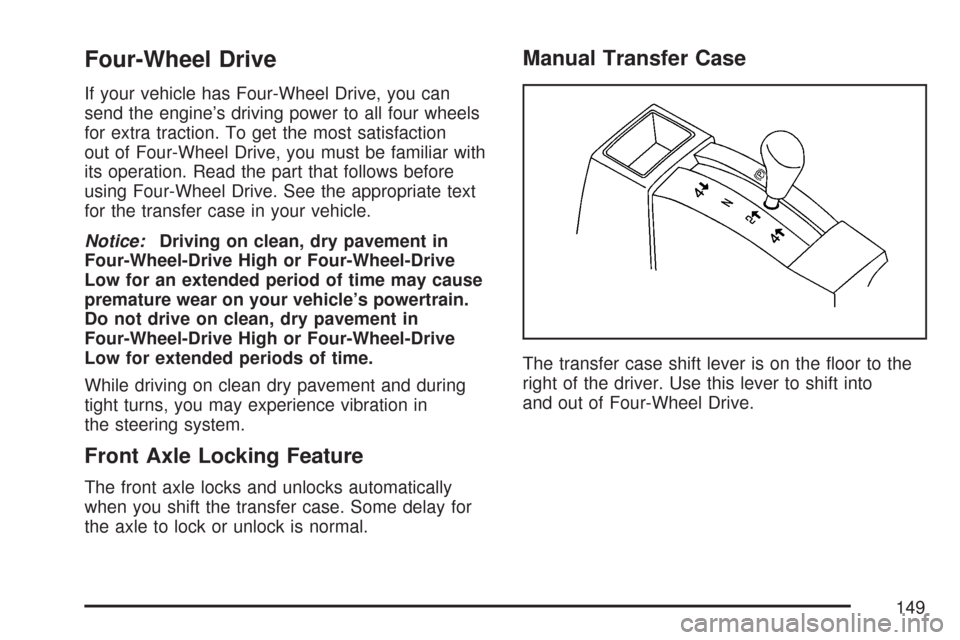
Four-Wheel Drive
If your vehicle has Four-Wheel Drive, you can
send the engine’s driving power to all four wheels
for extra traction. To get the most satisfaction
out of Four-Wheel Drive, you must be familiar with
its operation. Read the part that follows before
using Four-Wheel Drive. See the appropriate text
for the transfer case in your vehicle.
Notice:Driving on clean, dry pavement in
Four-Wheel-Drive High or Four-Wheel-Drive
Low for an extended period of time may cause
premature wear on your vehicle’s powertrain.
Do not drive on clean, dry pavement in
Four-Wheel-Drive High or Four-Wheel-Drive
Low for extended periods of time.
While driving on clean dry pavement and during
tight turns, you may experience vibration in
the steering system.
Front Axle Locking Feature
The front axle locks and unlocks automatically
when you shift the transfer case. Some delay for
the axle to lock or unlock is normal.
Manual Transfer Case
The transfer case shift lever is on the �oor to the
right of the driver. Use this lever to shift into
and out of Four-Wheel Drive.
149